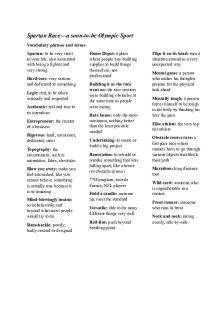Electronegativity sheet answers key PDF

| Title | Electronegativity sheet answers key |
|---|---|
| Author | Anonymous User |
| Course | Molecular Biology |
| Institution | Harvard University |
| Pages | 3 |
| File Size | 274.2 KB |
| File Type | |
| Total Downloads | 13 |
| Total Views | 134 |
Summary
yesssss really important sheet of electronegativity 9th grade...
Description
Electronegativity Worksheet 1. How are ionic bonds and covalent bonds different? -Ionic bonds are the result of giving or taking electrons. Whereas covalent bonds are the result of sharing electrons.
2. How does a polar covalent bond differ from a non-polar covalent bond?
When two atoms share a pair of electrons equally its a nonpolar covalent bond but when they share it inequally then it’s polar.
3. How do electronegativity values help us determine the polarity of a bond?
The more there is difference in electronegativity, the more a bond is polarised
4. Fill in the values to complete the following table for predicting bond type based on differences in electronegativity. 0.0 _______ _______ ______ 0.5 Non-polar Covalent bond
2.1 Polar Covalent Bond
3.3 Ionic Bond
5. Does electronegativity increase or decrease when you go across a period on the periodic table? Does it increase or decrease when you move down a group on the periodic table? Electronegativity increases across a period and decreases down a group.
6. For each of the following sets of elements, identify the element expected to be most electronegative (circle) and which is expected to be least electronegative (cross out), based on their position in the periodic table.
.
Use the table of electronegativities, above, to determine which type of bond should be formed between the two atoms.
7.
Atom 1
Atom 2
Phosphorus
Silicon
Electronegativity Difference Value
Si ( 1.90) P (2.19)
Bond Type (Non-polar Covalent, Polar, Ionic)
Si= Covalent bond P= Covalent bond
8.
Cobalt
Bromine
C (1.88) Br (2.8)
9.
Germanium
Selenium
Se (2.55) G ( 2.01)
10.
Silicon
Fluorine
Si (1.90) F (3.98)
11.
Potassium
Nitrogen
K (0.82) Na( 0.93)
12.
Cesium
Oxide
Cs (0.79) O( 3.5)
13.
Hydrogen
Phosphorus
P (2.19) H(2.2)
14.
Arsenic
Chloride
As(2.18) CI( 3.0)
15.
Lithium
Chloride
CI(3.0) Li( 0.98)
16.
Iron
Carbon
Fe( 1.83) C (2.5)
Br= covalent bond C= Metallic bond G= Covalent bond Se= Covalent bond F= Polar covalent Si= Polar covalent N= Ionic bond K= Ionic bond C= Ionic bond O=Ionic bond H= Non-polar covalent P= Non-polar covalent
A=covalently-bonded CI= covalently- bonded Li= Ionic bond CI= Ionic bond Fe= covalent bond C= covalent bond...
Similar Free PDFs

Key Exercise Shot Sheet
- 1 Pages

CapBud Try Sheet Key
- 39 Pages

Density Lab answers key
- 5 Pages

Key answers workbook - Solucionario
- 18 Pages

HW4 Key - Homework Answers
- 1 Pages

QUIZ#1 KEY Answers
- 3 Pages

Practice Sheet 17 Answers
- 2 Pages

Final exam review sheet key
- 2 Pages

Practice Sheet 15 Answers
- 4 Pages

14 Answers sheet - mkmkkm
- 3 Pages

1ST Grading EXAM KEY Answers
- 17 Pages
Popular Institutions
- Tinajero National High School - Annex
- Politeknik Caltex Riau
- Yokohama City University
- SGT University
- University of Al-Qadisiyah
- Divine Word College of Vigan
- Techniek College Rotterdam
- Universidade de Santiago
- Universiti Teknologi MARA Cawangan Johor Kampus Pasir Gudang
- Poltekkes Kemenkes Yogyakarta
- Baguio City National High School
- Colegio san marcos
- preparatoria uno
- Centro de Bachillerato Tecnológico Industrial y de Servicios No. 107
- Dalian Maritime University
- Quang Trung Secondary School
- Colegio Tecnológico en Informática
- Corporación Regional de Educación Superior
- Grupo CEDVA
- Dar Al Uloom University
- Centro de Estudios Preuniversitarios de la Universidad Nacional de Ingeniería
- 上智大学
- Aakash International School, Nuna Majara
- San Felipe Neri Catholic School
- Kang Chiao International School - New Taipei City
- Misamis Occidental National High School
- Institución Educativa Escuela Normal Juan Ladrilleros
- Kolehiyo ng Pantukan
- Batanes State College
- Instituto Continental
- Sekolah Menengah Kejuruan Kesehatan Kaltara (Tarakan)
- Colegio de La Inmaculada Concepcion - Cebu




